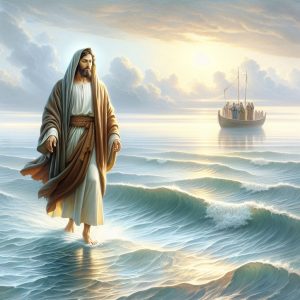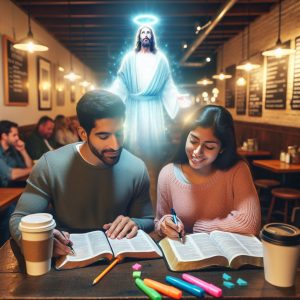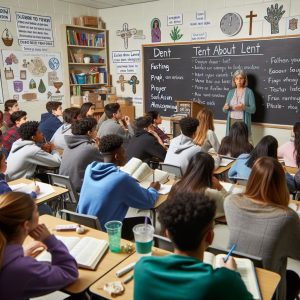Microsoft CoPilot Images
create a picture of Jesus walking on water

create a picture of a two people studying the bible imagining Jesus' transfiguration as they read the matching passage - they are in a coffee shop - with highlighters and notes in their bible

Create a picture of a religion grade 10 class for lent

make it a catholic school with uniforms

If an “algorithm is a set of rules for performing a task” than the task to create images from text would take a process of several different elements to produce an end product of a desired outcome. The algorithm to create these images is more than an if-then series, it is a plethora of outside data accumulating together. You can tell, from many different AI images, that many pictures aren’t created by the AI in its entirety. It often uses outside images and pastes them together to make one image.
- The last two images share this copy/paste trait.
- They both have similar bodies in the picture with a painted effect.
- They have items on the wall that are cut out in weird shapes and they are not all age appropriate.
- Student clothing in the second picture does not make much sense (the male appearing students are wearing kilts).
- The words are in a different language or are not fully developed words (they are missing letters).
- Faces are pieces of existing faces that are skewed.
- The Catholic School seems more regimented and not as fun, which plays into a bias.
These last two images of the classrooms do not provide enough exact detail where someone could imagine it was an actual photograph or an artist rendering. These images were how I predicted they turned out but I hoped for more developed images. While I think that AI has come along far, there is much need for improvement. If we look at the images provided in the module from Craiyon, these images are slightly less terrifying. Never-the-less, I think it is important to note that AI can take images from other sources or develop elements but there are some things like classrooms and faces that are only able to be created from the human experience.
Now, if we look at the first two images, they are well done with no scary faces. This could be because it could identify specific images from the internet to help formulate its image. It is interesting that it took a more artistic approach instead of an absolutely literal one like the classrooms. Perhaps it interpreted a dreamier atmosphere because it had to do with Jesus, which is upsetting but understandable from a non-worldly and non-religious kind of being. It is interesting to see what the AI takes as literal and what it takes as conceptual based on the language that is used within its own environment and others, or perhaps it takes what it thinks is literal based on specific opinions from the internet… But which ones will it pay attention to? Are there biases present from something that is not even human?